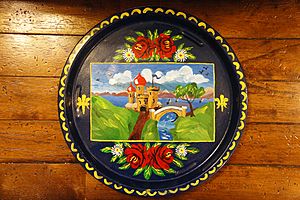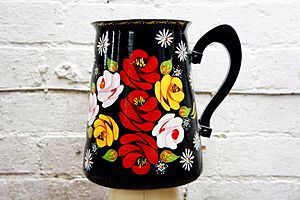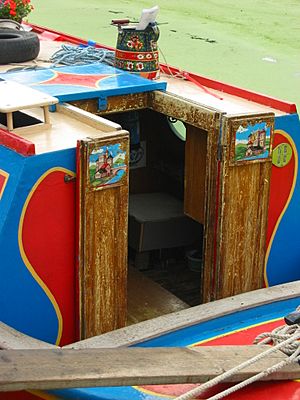Roses and Castles facts for kids

Tray painted in the traditional Roses and Castles style
|
|
| Years active | c. 1858–present |
|---|---|
| Country | United Kingdom |
| Influences | Folk art, Romani art |
Roses and Castles is a special type of art style used to decorate narrowboats and their items. This art often shows roses and castles. You might also see other flowers and pretty landscapes in the designs.
Contents
The Story of Roses and Castles Art
How This Art Style Started
The Roses and Castles art style probably began around the 1850s. This was when the British canal system was becoming less popular. Trains were taking over for moving goods.
Some people thought this art started in the early 1900s on the Llangollen Canal. They believed a worker there had many roses and a great view of Chirk Castle. But the art style was actually well-known by 1858.
There are a few ideas about how this art began. It looks a lot like the art on vardos, which are wagons used by Romani people. Maybe some Romani people worked on boats and brought their art with them. If so, the castles might have been inspired by castles in the Carpathian Mountains.
Another idea is that it started with a simple dog-rose design painted by a boatman or his family. This design then grew into what we see today. Also, the rose garlands look like decorations on Sheraton furniture from the early 1800s. It's most likely that this art style started in the Birmingham and Black Country areas of England. Roses were used in the art before castles were added. The first time castles were seen in narrowboat art was in 1873.
How Boatmen Used This Art
Many boatmen and their families spent a lot of time living on narrowboats. This artwork became a way to show their pride and unique style. One idea is that because families spent so much time on the canals, they were sometimes separated from others. The art became their "proud statement" of being different and keeping their traditions.
Boatmen paid for this art themselves. The boat companies usually only painted their boats with company colors. Things often painted in the Roses and Castles style included furniture inside the boat. They also painted items like the boat's headlamp and water cans.
L. T. C. Rolt wrote about how boatmen loved to decorate their boats. He said they would paint "fabulous castle scenes with garlands of roses." He even compared the painted boats to the decorated back of an old galleon ship.
Early on, some people called this art "the great teaboard school of art." This was a bit of an insult, comparing it to cheap tin trays. John Hollingshead described the style as "fanciful landscapes and several colorful wreaths of flowers."
What the Designs Look Like
The Roses and Castles style has been compared to folk art from Germany, the Netherlands, and Asia. It also looks very much like the designs on Romani Gypsy caravans. Robert Aickman said the designs were "brighter and gayer" than any other art like it in England. He also noted that the art helped to show off the waterways.
Boat painting was often done by workers at docks. Different dockyards, like those at Polesworth and Braunston, had their own special styles that you could recognize.



